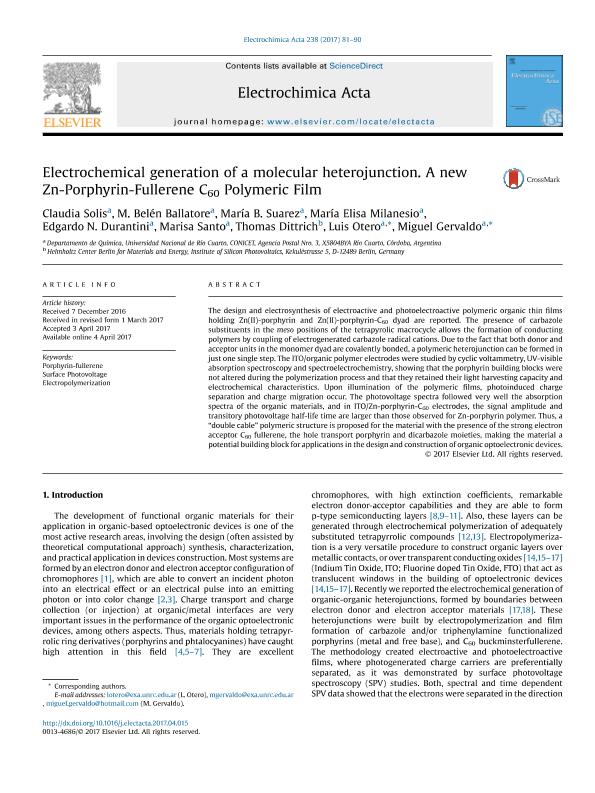Mostrar el registro sencillo del ítem
dc.contributor.author
Solis, Claudia Alejandra

dc.contributor.author
Ballatore, María Belén

dc.contributor.author
Suárez Ramanzin, Maria Belen

dc.contributor.author
Milanesio, María Elisa

dc.contributor.author
Durantini, Edgardo Néstor

dc.contributor.author
Santo, Marisa Rosana

dc.contributor.author
Dittrich, Thomas
dc.contributor.author
Otero, Luis Alberto

dc.contributor.author
Gervaldo, Miguel Andres

dc.date.available
2019-04-29T17:55:36Z
dc.date.issued
2017-06
dc.identifier.citation
Solis, Claudia Alejandra; Ballatore, María Belén; Suárez Ramanzin, Maria Belen; Milanesio, María Elisa; Durantini, Edgardo Néstor; et al.; Electrochemical generation of a molecular heterojunction. A new Zn-Porphyrin-Fullerene C60 Polymeric Film; Pergamon-Elsevier Science Ltd; Electrochimica Acta; 238; 6-2017; 81-90
dc.identifier.issn
0013-4686
dc.identifier.uri
http://hdl.handle.net/11336/75222
dc.description.abstract
The design and electrosynthesis of electroactive and photoelectroactive polymeric organic thin films holding Zn(II)-porphyrin and Zn(II)-porphyrin-C60 dyad are reported. The presence of carbazole substituents in the meso positions of the tetrapyrolic macrocycle allows the formation of conducting polymers by coupling of electrogenerated carbazole radical cations. Due to the fact that both donor and acceptor units in the monomer dyad are covalently bonded, a polymeric heterojunction can be formed in just one single step. The ITO/organic polymer electrodes were studied by cyclic voltammetry, UV-visible absorption spectroscopy and spectroelectrochemistry, showing that the porphyrin building blocks were not altered during the polymerization process and that they retained their light harvesting capacity and electrochemical characteristics. Upon illumination of the polymeric films, photoinduced charge separation and charge migration occur. The photovoltage spectra followed very well the absorption spectra of the organic materials, and in ITO/Zn-porphyrin-C60 electrodes, the signal amplitude and transitory photovoltage half-life time are larger than those observed for Zn-porphyrin polymer. Thus, a “double cable” polymeric structure is proposed for the material with the presence of the strong electron acceptor C60 fullerene, the hole transport porphyrin and dicarbazole moieties, making the material a potential building block for applications in the design and construction of organic optoelectronic devices.
dc.format
application/pdf
dc.language.iso
eng
dc.publisher
Pergamon-Elsevier Science Ltd

dc.rights
info:eu-repo/semantics/openAccess
dc.rights.uri
https://creativecommons.org/licenses/by-nc-sa/2.5/ar/
dc.subject
Electropolymerization
dc.subject
Porphyrin-Fullerene
dc.subject
Surface Photovoltage
dc.subject.classification
Otras Ciencias Químicas

dc.subject.classification
Ciencias Químicas

dc.subject.classification
CIENCIAS NATURALES Y EXACTAS

dc.title
Electrochemical generation of a molecular heterojunction. A new Zn-Porphyrin-Fullerene C60 Polymeric Film
dc.type
info:eu-repo/semantics/article
dc.type
info:ar-repo/semantics/artículo
dc.type
info:eu-repo/semantics/publishedVersion
dc.date.updated
2019-04-16T20:39:00Z
dc.journal.volume
238
dc.journal.pagination
81-90
dc.journal.pais
Estados Unidos

dc.description.fil
Fil: Solis, Claudia Alejandra. Universidad Nacional de Río Cuarto. Facultad de Ciencias Exactas Fisicoquímicas y Naturales. Departamento de Química; Argentina. Consejo Nacional de Investigaciones Científicas y Técnicas. Centro Científico Tecnológico Conicet - Córdoba; Argentina
dc.description.fil
Fil: Ballatore, María Belén. Universidad Nacional de Río Cuarto. Facultad de Ciencias Exactas Fisicoquímicas y Naturales. Departamento de Química; Argentina. Consejo Nacional de Investigaciones Científicas y Técnicas. Centro Científico Tecnológico Conicet - Córdoba; Argentina
dc.description.fil
Fil: Suárez Ramanzin, Maria Belen. Universidad Nacional de Río Cuarto. Facultad de Ciencias Exactas Fisicoquímicas y Naturales. Departamento de Química; Argentina. Consejo Nacional de Investigaciones Científicas y Técnicas. Centro Científico Tecnológico Conicet - Córdoba; Argentina
dc.description.fil
Fil: Milanesio, María Elisa. Universidad Nacional de Río Cuarto. Facultad de Ciencias Exactas Fisicoquímicas y Naturales. Departamento de Química; Argentina. Consejo Nacional de Investigaciones Científicas y Técnicas. Centro Científico Tecnológico Conicet - Córdoba; Argentina
dc.description.fil
Fil: Durantini, Edgardo Néstor. Consejo Nacional de Investigaciones Científicas y Técnicas. Centro Científico Tecnológico Conicet - Córdoba; Argentina. Universidad Nacional de Río Cuarto. Facultad de Ciencias Exactas Fisicoquímicas y Naturales. Departamento de Química; Argentina
dc.description.fil
Fil: Santo, Marisa Rosana. Universidad Nacional de Río Cuarto. Facultad de Ciencias Exactas Fisicoquímicas y Naturales. Departamento de Química; Argentina
dc.description.fil
Fil: Dittrich, Thomas. Institute For Silicon Photovoltaics; Alemania
dc.description.fil
Fil: Otero, Luis Alberto. Consejo Nacional de Investigaciones Científicas y Técnicas. Centro Científico Tecnológico Conicet - Córdoba; Argentina. Universidad Nacional de Río Cuarto. Facultad de Ciencias Exactas Fisicoquímicas y Naturales. Departamento de Química; Argentina
dc.description.fil
Fil: Gervaldo, Miguel Andres. Universidad Nacional de Río Cuarto. Facultad de Ciencias Exactas Fisicoquímicas y Naturales. Departamento de Química; Argentina. Consejo Nacional de Investigaciones Científicas y Técnicas. Centro Científico Tecnológico Conicet - Córdoba; Argentina
dc.journal.title
Electrochimica Acta

dc.relation.alternativeid
info:eu-repo/semantics/altIdentifier/url/https://www.sciencedirect.com/science/article/pii/S0013468617307570
dc.relation.alternativeid
info:eu-repo/semantics/altIdentifier/doi/http://dx.doi.org/10.1016/j.electacta.2017.04.015
Archivos asociados
